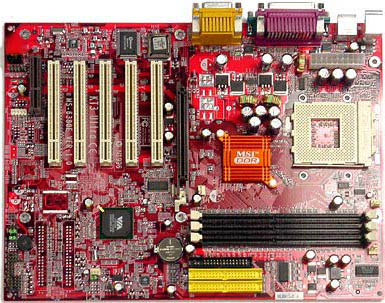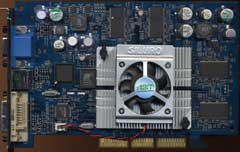Buyer's Guide: Value Professional 3D - October 2002
by Matthew Witheiler on October 8, 2002 1:45 AM EST- Posted in
- Guides
Value Professional 3D
 Processor
- AMD Athlon XP 1900+ (1.6GHz) - $85
Processor
- AMD Athlon XP 1900+ (1.6GHz) - $85
AMD processors have historically done win in professional 3D environments. Depending on the situation, we have found the Athlon XP to perform very strongly in a number of professional 3D applications such as Maya and 3D Studio Max. In a number of instances the Athlon XP 1900+ that we recommend here performed at or above the speeds of Intel Pentium 4 processors costing $100 more. This makes the Athlon XP processor the best solution for our value professional 3D system.
We bumped up the speed of our CPU this time around, going from an Athlon XP 1800+ to an Athlon XP 1900+. The extra speed ended up costing $8, an amount which is trivial especially in the case of a professional 3D workstation where CPU performance is a large factor in application performance. The next step up, the Athlon XP 2000+, runs $14 more and would offer fairly little in terms of performance.
For more information on the AMD Athlon XP processor, check out our most recent AMD Athlon XP review.
Motherboard - MSI MS-6380E KT3 Ultra2 - $75
Our last value professional 3D system recommended the MSI KT3 Ultra motherboard as the motherboard of choice. We decided upon the KT3 Ultra for a number of reasons. First, we were pleased at the price that the KT333 motherboard was being offered at (very close in price to the older KT266A motherboards). Secondly, we chose the KT3 Ultra because of its integrated 6 channel audio solution (provided by a Avance Logic ALC650 chip). Finally, we decided upon the KT3 Ultra because it won our Editors Choice Silver award in our KT333 roundup.
This time around we slightly modify our motherboard selection. Today we replace the KT3 Ultra with the updated KT3 Ultra2, just as we did in our value gaming guide. The two are essentially the same motherboard except the KT3 Ultra2 now uses VIA's new southbridge solution, the VT8235, which adds USB 2.0 support. The board still maintains the quality build, stability, and integrated sound that got it here in the first place. The bottom line is that the KT3 Ultra2 is only $10 more than the KT3 Ultra was seven weeks ago and is the next logical step in the KT3 Ultra series evolution.

You can read more about the MSI KT3 Ultra in our KT333 roundup and more about the KT333 chipset in general in our VIA KT333 article.
Memory - 512MB Mushkin PC2700 DDR SDRAM - $169
Memory plays an important role in professional 3D workstations so we decided that 512MB was a minimum requirement even for our value configuration. We opted for slightly more expensive PC2700 memory and not PC2100 memory based on the fact that the increased memory bandwidth should result in some tangible gains in the performance of 3D applications.
Memory prices remain the same as they were seven weeks ago in our last professional 3D buyer's guide. Again, we chose to go with slightly more expensive memory from a reputable manufacturer as opposed to cheaper memory from a no-name company. Motherboards, especially those of the KT333 variety, can be very picky when it comes to what memory it will run with. Trust us when we say that the extra money you spend buying from Mushkin, Crucial, Kengston, ect is well worth it.

Since we can afford to be a bit more lenient with price in our value professional 3D system we chose to outfit it with a GeForce4 Ti 4200, the same card we chose to put in our last value professional 3D system. We knew that putting a DirectX 8 card in our value professional 3D system was a must as it is only with a DirectX 8 ready card that we can take advantage of vertex and pixel shaders. The professional 3D NVIDIA cards that include this functionality, the Quadro4 XGL cards, are priced far to high to find their way into a value system of any sorts. Don't fret: the hardware antialiased lines, hardware overlay planes, and two-sided lighting that the Quadro cards offer wont be missed much but the $400 or so that you save by going with the Ti 4200 would be.

We would suggest you stay away from previous generation Quadro based cards. Although prices of Quadro2 cards have fallen quite a bit from their prices a year ago, the cards miss out on the advanced GeForce4 features such as DX 8 compatibility and an enhanced T&L engine. When deciding what GeForce4 Ti 4200 to go with, just stick with the least expensive one you can find. We saw in our GeForce4 Ti 4200 roundup that all 4200 cards are created equal. The price of the least expensive GeForce4 Ti 4200 card in our recent price guide was $126. This represented a $14 decrease in price from last value professional 3D buyer's guide and make the card even more attractive to the value market.
The other card you may consider going with is the card we placed in our value gaming system, the ATI Radeon 8500 LE. The 8500 LE will not be as fast as the GeForce4 Ti 4200 but it will cost you about $40 less.
Be sure to check out our GeForce4 Ti 4200 roundup for more information about the NVIDIA GeForce4 Ti 4200.
Monitor - Cornerstone C1035 - $499
 Just
like 19" monitor prices, 21" monitor prices have been falling the
recent months. We decided that the extra money that a 21" monitor will
cost you is worth it on a professional 3D system such as this one. We chose
to recommend the Cornerstone C1035 due to our personal
experience with it. Again, this is the same recommendation made almost two
months ago in our last value professional 3D buyer's guide.. During our testing
we were very pleased with the monitor and found that it was able to provide
quite the bang for the buck.
Just
like 19" monitor prices, 21" monitor prices have been falling the
recent months. We decided that the extra money that a 21" monitor will
cost you is worth it on a professional 3D system such as this one. We chose
to recommend the Cornerstone C1035 due to our personal
experience with it. Again, this is the same recommendation made almost two
months ago in our last value professional 3D buyer's guide.. During our testing
we were very pleased with the monitor and found that it was able to provide
quite the bang for the buck.
You are fairly safe going with a 21" monitor from any major monitor manufacturer. Just make sure that it can display a resolution of at least 1600x1200 at a refresh rate of 70Hz or above.
For more information on the Cornerstone C1035, check out the review we did on the monitor.










0 Comments
View All Comments